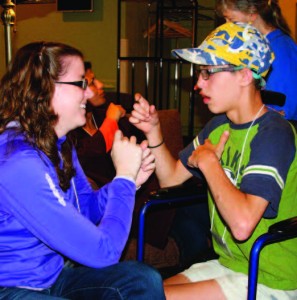Deaf-blind Get “In Touch” with Halachah

Liad Kuhl, of Charleston, West Virginia, who is deaf and blind, uses tactile sign language to communicate. Photo: Sheryl Cooper
Our Way’s “Illuminating” New Sefer
We all, to some degree, communicate through touch. For the Jewish deaf-blind, it’s the only way. They literally “speak” and “listen” into each other’s hands. This raises serious halachic questions.
What if the signers are opposite genders; are they obligated to keep the laws of negiah? Can spouses use tactile signing and still honor the laws of family purity?
To address these and other she’eilot concerning this population, Our Way for the Jewish Deaf and Hard of Hearing, a division of the OU’s National Jewish Council for Disabilities (NJCD), is publishing Halachos for the Jewish Deaf-blind. Our Way provides social, educational and recreational programs for Jews who are deaf and hard of hearing. The book, compiled by Rabbi Shimon Taub, a noted Torah scholar from Brooklyn and author of The Laws of Tzedakah and Maaser, A Comprehensive Guide (Brooklyn, 2001), is the first of its kind.
“One might think that because the deaf-blind have so many challenges, they should be absolved from keeping halachah,” says Rabbi Eliezer Lederfeind, director of Our Way. “That would be tantamount to saying, ‘It doesn’t matter what you do, and you’re not really part of the [Jewish] family.’”
Many deaf-blind Jews suffer from a rare genetic disorder called Usher syndrome, characterized by deafness and gradual vision loss. According to Estie Rose, genetic counselor at Yeshiva University’s Program for Jewish Genetic Health, two types of Usher syndrome are more common in the Ashkenazic Jewish population than in the general population. Usher syndrome type IF has a carrier frequency of about one in 141 in the Ashkenazic Jewish population, and type III has a carrier rate of about one in 107 in the Ashkenazic Jewish population. Carriers of Usher syndrome do not exhibit any symptoms of the condition; however, if two carriers of the same type of Usher syndrome get married, with each pregnancy there is a one in four chance of having a child with Usher syndrome. Carrier testing through a simple blood test is affordable and accessible, and is recommended prior to pregnancy.
The Gemara states that a cheresh, defined as a deaf-mute (i.e., an individual who can’t communicate) lacks the ability to develop the maturity required to understand his obligation in mitzvah observance, and is therefore exempt from that responsibility. With the advent of sign language and, more recently, electronic communication devices, posekim question whether the exemption still applies to deaf and deaf-blind individuals.
“If a person doesn’t have a means of communication, he can’t develop normal thinking patterns, a sense of responsibility and appropriateness,” says Rabbi Mordechai Shuchatowitz, the father of four hearing-impaired children and rabbi of Agudath Israel of Greenspring in Baltimore, Maryland. He is also the author of the two-volume The Toras Hacheresh Guidebook: A Practical Guide to the Use of Electronic Hearing Devices on Shabbos and Yom Tov (Our Way, 2003). “But now they can overcome that disability and become bnei da’at [capable of fulfilling mitzvot].”
Rabbi Taub’s guide, with text in both Hebrew and English, explores the most common halachic issues pertaining to the deaf-blind. It also sends out the crucial message that they are full-fledged members of Klal Yisrael.
Rabbi Taub and Rabbi Lederfeind toured the Helen Keller National Center in Long Island for Deaf-Blind Youths and Adults to meet deaf-blind individuals and observe firsthand how they live and function. After discerning their specific challenges, Rabbi Taub compiled a list of potential halachic issues. Aside from the question of physical contact, he explores the halachic ramifications of using a walking stick on Shabbat, bringing a guide dog into shul and using assistive technology on Shabbat and yom tov, among other issues.
“There is nothing new to Torah,” says Rabbi Taub, who conferred with Rabbi Yisroel Belsky, a senior halachic consultant for the OU, while composing the guide. “Even when the biggest posekim come up with kulot [leniencies], they are not creating them; they are extrapolating what was already there and applying it to the current situation.”
Drawing on Rambam’s position on the laws of negiah, Rabbi Taub explains that, under very limited circumstances, touching may be permitted where there is no intent for physical pleasure. However, Rabbi Taub stresses that when a deaf-blind individual seeks to hire an SSP (a trained paraprofessional who, via tactile signing, fosters interaction between the deaf-blind individual and his surroundings, e.g., informs him who is in the room, who is speaking, when to sit down for lunch, et cetera), he or she should make every effort to find someone of the same gender. The leniency only applies when there is no other option. “The point is to try to find heterim within halachah,” says Rabbi Taub. “The average person doesn’t have to rely on kulot. But when dealing with people who have no other form of communication, there are kulot that one would be permitted to rely on.”
Our Way plans to e-mail copies of the guide to their deaf-blind members, as well as send hard copies to OU shuls and community leaders across the country. Braille editions will also be available. “We’re trying to create an awareness that this population exists,” says Rabbi Lederfeind. To further that goal, he included a section in the guide describing how a shul can make itself accessible to deaf-blind mitpallelim.
“It’s a small and scattered population,” says Rabbi Lederfeind. “[Consequently], it has been greatly underserved by the Jewish community.”
He hopes this groundbreaking book, which is expected to be published later this summer, will help change that. To obtain the book, contact ourway@ou.org or 212-613-8234.
Bayla Sheva Brenner is senior writer in the OU Communications and Marketing Department.
